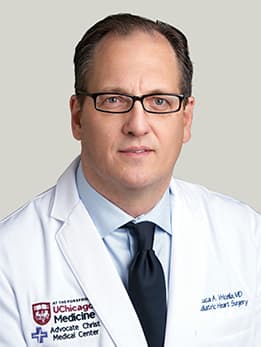Growing up with congenital heart disease

Learning that your baby has congenital heart disease can feel overwhelming and devastating. At the University of Chicago Medicine, we recognize this news is scary. We believe that with the right help and proper guidance, caring for a child with congenital heart disease is manageable and can be made easier.
Congenital heart disease can be any of the more than 200 types of defects that are present at birth in the structure of the heart. The operations to treat congenital heart defects span from relatively simple procedures to the most complicated forms of intervention and re-intervention. These can take place before a child is born, during their childhood, or when they are adults.
Of the estimated 2.4 million people living with congenital heart disease, about 1 million are under the age of 18. In the past, it wasn’t unusual for people to find out much later in life that they had a heart abnormality. That’s in part because many less-serious defects do not cause symptoms. Today, however, most congenital heart defects — such as a ventricular septal defect (a hole between the two lower chambers of the heart) — can be accurately diagnosed before a baby is born and as early as the fourth or fifth month of pregnancy, thanks to fetal echocardiography, a specialized, noninvasive type of ultrasound used to examine a fetus’ heart.
A timely diagnosis means families and physicians can better prepare for the baby’s needs and ensures your child receives prompt care for their heart, even immediately after birth if needed. An early and detailed discussion with your child’s cardiologist and surgeon helps you understand the complexities and expectations involved in the care of your baby’s heart condition after birth.
Depending on the defect, doctors may recommend intervention with a cardiac catheterization or surgery. Your child may need a repair or correction — when the surgeon fully restores the heart's anatomy and circulation back to normal so that it becomes a regular, working heart — or a palliation, when a heart cannot be fully repaired but can be made to function in a stable manner.
Some children will need several stages of treatment when it comes to palliation: an operation right after birth, an operation in another four to six months and a third operation at 2 or 3 years of age.
The goal of a palliative surgery is to relieve your child’s symptoms and allow for an improved quality of life so that they’ll be able to participate in everyday activities like playing with friends and attending school. Palliative surgeries also act as a bridge to extend the time before the heart may need to be transplanted.
Patients with congenital heart disease may have to modify their lifestyle and diet, and/or take medications to control their heartbeat, fluid balance or blood pressure. For instance, patients with an aortic aneurysm should avoid isometric sports that involve static strength, such as weightlifting and gymnastics.
Medications such as blood thinners can also affect how much a person exercises and the types of sports they do, as well as the foods they eat. Being on a blood thinner medication increases a person’s chance of bleeding, so your child may have to avoid contact sports. Additionally, some foods interact with these medications in the body and either increase or decrease their effect.
As children with congenital heart disease grow to be adults, they often require additional interventions. This may be due to their heart disease progressing, or sometimes because their bodies outgrow the original devices or implants – such as valves, conduits and tubes – used to repair their hearts.
These adults with congenital heart disease are then managed by a niche group of specially trained cardiologists at our comprehensive Adult Congenital Heart Program.
University of Chicago Medicine researchers and physicians are working to limit the number of surgeries patients must undergo by developing devices such as heart valves that can be delivered by a cardiac catheterization, as well as biodegradable stents. These could one day simplify highly complex cardiac surgeries and improve patient outcomes.
When a child is diagnosed with a congenital heart defect, they may become a cardiac patient for life. But with help from their family and a devoted cardiac care team at the leading edge of research and innovative treatments, these children can smoothly transition to an active, normal adulthood.

Madhusudan Ganigara, MD
Madhusudan Ganigara, MD, is a highly skilled pediatric cardiologist who diagnosis and treats children with heart disease or defects. Dr. Ganigara's goal is to find the best and safest treatment for his pediatric heart patients.
Learn more about Dr. Ganigara
Luca Vricella, MD
Luca Vricella, MD, is a highly renowned pediatric cardiac surgeon who is passionate about helping children have fulfilling lives after being treated for heart disease.
Learn more about Dr. Vricella